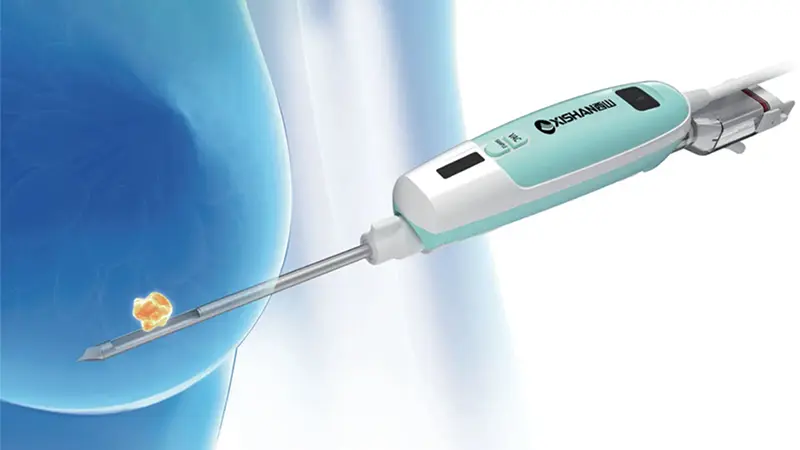Sentinel Lymph Node Biopsy
Breast cancer management is based on the stage of disease. Breast cancer starts in the breast and can spread to the rest of the body either through blood or through lymphatics.

When the disease spreads through lymphatics, the first station is found in the armpit.
The disease grows in the lymph nodes in the armpit and when they are large enough can be felt for examination. When lymph nodes are enlarged we remove them during breast cancer surgery.
If the disease is not big enough the lymph nodes may not be felt. Traditionally these arm pit lymphnodes are removed routinely as part of mastectomy and such surgery comes with complications like swelling of the arm ( lymphedema). In almost 30 percent of such patients who do not have enlarged glands in the arm pit, the surgery done in the armpit is un necessary as the disease has not spread.
Sentinel lymph node biopsy (SLNB) is a surgical procedure used to determine whether breast cancer (or other types of cancer) has spread to the lymphatic system. It focuses on identifying and removing the sentinel lymph nodes, which are the first lymph nodes to which cancer cells are likely to spread from a primary breast tumor. This procedure helps to avoid the need for more extensive lymph node removal, reducing the risk of complications such as lymphedema (swelling due to lymph fluid buildup).
Purpose of Sentinel Lymph Node Biopsy:
SLNB is primarily used in non metastatic breast cancer to:
Procedure Overview
The sentinel lymph node biopsy involves several key steps:
1. Injection of Dye or Radioactive Tracer
- Before the procedure, a radioactive tracer (technetium) and/or blue dye (methylene blue or isosulfan blue) is injected near the cancer in the breast or under the skin around the areola.
- The dye or tracer moves through the lymphatic system to the sentinel lymph nodes, highlighting them for removal.
2. Identifying the Sentinel Nodes:
- The sentinel lymph nodes are identified using a gamma detector (to detect the radioactive tracer) or visually by identifying the blue-stained nodes from the dye.
- The sentinel nodes are the first to receive lymphatic drainage from the tumor and are most likely to contain cancer cells if the cancer has spread.
3. Removal of Sentinel Lymph Nodes:
- Once the sentinel nodes are located, the surgeon makes a small incision (usually under the arm) and removes one or a few sentinel nodes for analysis.
- Typically, only 1 to 4 lymph nodes are removed during this procedure, depending on how many are identified.
4. Pathological Examination:
- The removed sentinel nodes are sent to a pathology lab for examination under a microscope. The pathologist looks for the presence of cancer cells in the lymph nodes.
- Results from the pathology exam are used to determine if the cancer has spread to the lymph nodes and to guide further treatment decisions.
Benefits of Sentinel Lymph Node Biopsy :
The biopsy is performed with real-time guidance from imaging techniques, such as
Who is a Candidate for SLNB?
Sentinel lymph node biopsy is generally recommended for:
- Women with breast cancer who have no signs of lymph node involvement on imaging or physical exam.
- Patients with ductal carcinoma in situ (DCIS) undergoing a mastectomy, since there's a small risk that invasive cancer may be found.
- Women undergoing mastectomy or breast-conserving surgery who want to avoid more extensive lymph node removal.

Sentinel Lymph Node Biopsy Results
Negative SLNB
- If the sentinel lymph nodes are negative (no cancer cells are found), it usually indicates that the cancer has not spread to the lymph nodes. In this case, no further lymph node surgery is necessary.
- Treatment will focus on the primary tumor, and systemic therapy (e.g., chemotherapy, hormone therapy) may still be recommended based on other factors.
Positive SLNB
- If the sentinel lymph nodes are positive (cancer cells are present), it indicates that the cancer has spread beyond the breast.
- Further surgery may be recommended, such as axillary lymph node dissection (removal of additional lymph nodes) to remove any remaining cancerous nodes.
- Additional treatments like chemotherapy, radiation therapy, or hormone therapy may also be recommended based on the cancer’s characteristics.
Risks and Complications
Although sentinel lymph node biopsy is generally safe, there are some potential risks:
Lymphedema
Although the risk is lower with SLNB than with axillary lymph node dissection, there is still a small chance of developing lymphedema.
Infection or Bleeding
As with any surgical procedure, there is a risk of infection or bleeding at the biopsy site.
Nerve Damage
Rarely, damage to nerves in the area may occur, causing temporary or permanent numbness or weakness in the arm.
Allergic Reaction
Some patients may have an allergic reaction to the blue dye used during the procedure, though this is uncommon.
Temporary Skin Discoloration
The blue dye may temporarily discolor the skin and urine, but this effect fades over time.
Recovery After Sentinel Lymph Node Biopsy
- Most patients experience minimal discomfort after the procedure and can return to normal activities within a few days.
- Some patients may experience mild swelling, bruising, or soreness at the incision site, but these symptoms usually improve within a week or two.
- Heavy lifting and strenuous activities should be avoided for a short time after surgery to promote healing.

Conclusion
Sentinel lymph node biopsy is a critical procedure in the staging and management of breast cancer. It offers a less invasive way to determine whether cancer has spread to the lymph nodes, with fewer side effects than traditional lymph node removal. The results of SLNB help guide further treatment decisions, potentially sparing patients from more extensive surgery and its associated complications.



